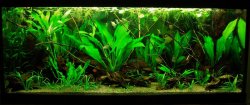chadschuster0321
Mostly New Member
I'm moving in the next month or so, and I've decided to take my Amazonian fish from my 90 gallon and 36 Gallon and move them into an old 100 Gallon I have, and keep the rest of the fish in the 90 gallon.
STOCKING
My Amazonian fish currently go as follows:
6x Corydoras Catfish
2x Angelfish (I originally had 5 but lost 3)
2x Discus
2x Bolvian Rams
1x German Blue Rams
Fish I am going to purchase:
3x Angelfish
3x Discus
2x German Blue Rams
6x Rummynose Tetras
6x Neon Tetras
1x Bushynose Pleco
Totals at:
5x Angelfish
5x Discus
3x German Blue Rams
2x Bolvian Rams
6x Rummynose Tetras
6x Neon Tetras
6x Corydoras Catfish
1x Bristlenose Pleco
Does anyone think this would be overstocked?
PLANTING
I've decided that finding Amazonian only plants is going to be too much work, considering I would only consider myself an intermediate fish keeper. I'm going to try and completely fill the tank with plants, does anyone recommend any, Amazonian would be preferred but not necessary.
I can't wait till I am able to get to work on this aquarium, please leave your comments and questions below, thanks.
STOCKING
My Amazonian fish currently go as follows:
6x Corydoras Catfish
2x Angelfish (I originally had 5 but lost 3)
2x Discus
2x Bolvian Rams
1x German Blue Rams
Fish I am going to purchase:
3x Angelfish
3x Discus
2x German Blue Rams
6x Rummynose Tetras
6x Neon Tetras
1x Bushynose Pleco
Totals at:
5x Angelfish
5x Discus
3x German Blue Rams
2x Bolvian Rams
6x Rummynose Tetras
6x Neon Tetras
6x Corydoras Catfish
1x Bristlenose Pleco
Does anyone think this would be overstocked?
PLANTING
I've decided that finding Amazonian only plants is going to be too much work, considering I would only consider myself an intermediate fish keeper. I'm going to try and completely fill the tank with plants, does anyone recommend any, Amazonian would be preferred but not necessary.
I can't wait till I am able to get to work on this aquarium, please leave your comments and questions below, thanks.





 /gyazo.com/aa094631475fcb3e7de58e042624758f
/gyazo.com/aa094631475fcb3e7de58e042624758f